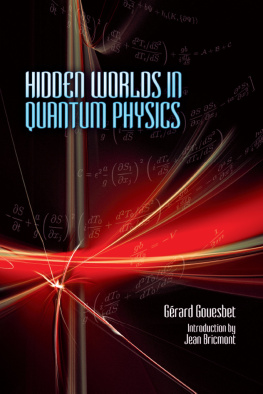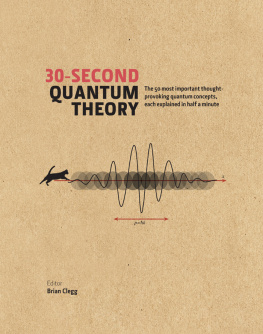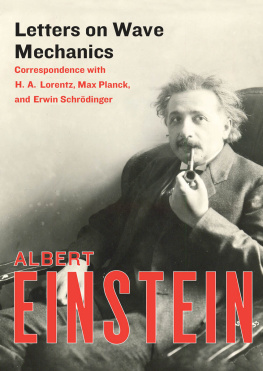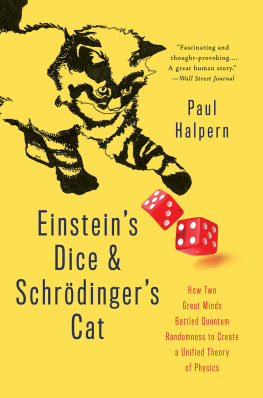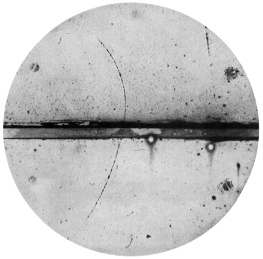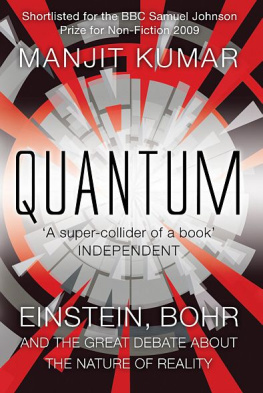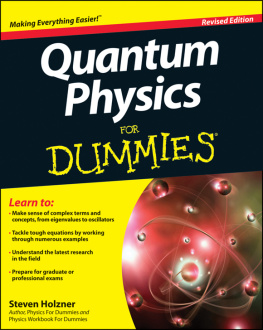Gouesbet - Hidden Worlds in Quantum Physics.
Here you can read online Gouesbet - Hidden Worlds in Quantum Physics. full text of the book (entire story) in english for free. Download pdf and epub, get meaning, cover and reviews about this ebook. year: 2013, publisher: Dover Publications, genre: Religion. Description of the work, (preface) as well as reviews are available. Best literature library LitArk.com created for fans of good reading and offers a wide selection of genres:
Romance novel
Science fiction
Adventure
Detective
Science
History
Home and family
Prose
Art
Politics
Computer
Non-fiction
Religion
Business
Children
Humor
Choose a favorite category and find really read worthwhile books. Enjoy immersion in the world of imagination, feel the emotions of the characters or learn something new for yourself, make an fascinating discovery.
Hidden Worlds in Quantum Physics.: summary, description and annotation
We offer to read an annotation, description, summary or preface (depends on what the author of the book "Hidden Worlds in Quantum Physics." wrote himself). If you haven't found the necessary information about the book — write in the comments, we will try to find it.
Hidden Worlds in Quantum Physics. — read online for free the complete book (whole text) full work
Below is the text of the book, divided by pages. System saving the place of the last page read, allows you to conveniently read the book "Hidden Worlds in Quantum Physics." online for free, without having to search again every time where you left off. Put a bookmark, and you can go to the page where you finished reading at any time.
Font size:
Interval:
Bookmark:
HIDDEN WORLDS IN QUANTUM PHYSICS
Grard Gouesbet
Laboratoire dElectromagntisme des
Systemes Particulaires (LESP)
Unit Mixte de Recherche (UMR)
du
Centre National de la Recherche Scientifique (CNRS)
Complexe de Recherche Interprofessionnel en
Aerothermochimie (CORIA)
Universit de Rouen
et
Institut National des Sciences Appliques (INSA) de Rouen
Introduction by
Jean Bricmont
DOVER PUBLICATIONS, INC.
Mineola, New York
Copyright
Copyright 2013 by Grard Gouesbet
Introduction Copyright 2013 by Jean Bricmont
All rights reserved.
Bibliographical Note
Hidden Worlds in Quantum Physics is a new work, first published by
Dover Publications, Inc., in 2013.
International Standard Book Number
eISBN-13: 978-0-486-31574-4
Manufactured in the United States by Courier Corporation
49966901 2013
www.doverpublications.com
Contents
INTRODUCTION
This book by Grard Gouesbet gives an extraordinarily encyclopedic overview of the hidden worlds of quantum mechanics, based on his vast knowledge of both physics and philosophy. He covers almost every possible problem posed by quantum mechanics and almost every possible interpretation or alternative view of quantum mechanics that has been proposed.
Ever since its inception in the 1920s, quantum mechanics has provoked heated debates between physicists as well as between philosophers. On the one hand, there is an orthodox view, often called the Copenhagen interpretation, whose name refers to the Danish physicist Niels Bohr who, together with Werner Heisenberg, Wolfgang Pauli, Max Born, and many other eminent physicists developed this view. On the other hand, there have always been critics of this view, also including eminent physicistsAlbert Einstein, Erwin Schrdinger, Louis de Broglie, David Bohm, and John Bell, among others.
In this preface, I would like to outline what are the real problems raised by quantum mechanics and what could be a possible solution to those problems. What follows is of course based on the work of the critics of the orthodox interpretation, who are discussed in detail by Grard Gouesbet.
In quantum mechanics, one associates to any physical system an abstract mathematical object, called the wave function or the state vector. This state changes with time according to precise rules that, in practice, are nonambiguous. Thanks to those rules, one can make a great number of predictions that are spectacularly well confirmed experimentally. Moreover, quantum theory is at the basis of all modern electronics and therefore of all informatics and telecommunications.
The problem is that it is difficult to say what the state vector means. Indeed, in many situations, it is in a superposed state, which is often explained by saying that the system possesses simultaneously mutually exclusive properties. For example, it could be both black and whitenot gray, but simultaneously completely black and completely white. Of course, we are not talking here literally about colors but about properties such as spin, or energy, or polarization, or angular momentum. And, of course, when we observe something, we never find both of these mutually exclusive properties but only one of them. The state is then supposed to collapse or be reduced to a state that is no longer a superposition of states with different properties but a state with only one of those properties.
It has to be emphasized that a superposed state is not supposed to be understood only in the sense of reflecting our ignorance, as if we simply did not know whether the particle is black or white, until we look. If that were the case, it would be like a coin that is either heads or tails; we may not know in which state it is until we look, but we know that it is in one or the other and, by looking, we simply learn which one it is. In ordinary quantum mechanics, there is no sense attached to the idea that the system is either black or white before one looks, and that makes the situation radically different from the one of classical probabilities, such as coin tossing.
Why do physicists use such a language? Because if one did not use the language of superposed states, if instead, one attributed a state corresponding to only one of the two superposed properties to the system, many empirically correct results could not be derived.
An example of such a use of superposed states is given by the double-slit experiment. A set of particles is sent toward a wall in which two slits can be opened and the particles are detected on another wall at a certain distance behind the first wall. If only one slit is open, we find a certain distribution of particles on the second wall, centered around the slit, as one would expect in a random experiment, meaning that not all particles passing through the slit follow exactly the same path. If only the other slit is open, one finds a similar distribution centered around the second slit. If both slits are open, one would naively expect the distribution of particles to be the sum of the distributions obtained when each slit is open. But that is not the case: The particles distribute themselves as if a wave had been going though both slits, displaying an interference pattern, with places where there are even fewer particles arriving than when only one slit is open.
One sometimes describes that experiment by saying that the particle sometimes behaves as a wave (when both slits are open) and sometimes as a particle (when only one slit is open); hence, one speaks of waveparticle duality. One also says that the particle goes through both slits (when they are both open), which is an example of mutually incompatible properties.
But all that does not answer the question of what the state vector means nor does it allow us to understand how to think about superposed states.
To dramatize the problem, Schrdinger invented his famous example of the cat. Imagine a cat in a sealed room together with a capsule containing a poison that can kill the cat if the capsule is open. Imagine also a mechanism that, when one measures whether a system is black or white (to follow our metaphor), breaks the capsule if the result is white and does not break it if it is black. Then, if one applies the rules of quantum mechanics to that entire system (including the capsule and the cat), the cat is both dead and alivenot in between life and death but completely alive and completely dead.
Schrdinger viewed this situation, which he called quite ridiculous, as a reductio ad absurdum of the traditional interpretation of quantum mechanics, i.e., of the idea that the quantum state gives a complete description of the system. In the case of the cat, the description of it as both dead and alive cannot possibly be complete.
Of course, in the usual interpretation, the state vector is applied to microscopic objects, not to macroscopic ones, like measuring devices or a cat, but it is never stated where one puts the dividing line between the two. If one applied the logic of quantum mechanics to every object, large or small, then, as Schrdinger showed, one easily arrives at the cat problem. And, if quantum mechanics applies to an atom, or two atoms, or ten, where does one put the limit between that and a cat?
One possible answer to that puzzle is to say that the state vector does not mean anything physically, but it only enters into an algorithm through which results of measurements can be predicted, and nothing else. But the following question then arises: What is the point of such predictions? In science, the role of experiments is to test theories, but the theories themselves are about the world, not only
Next pageFont size:
Interval:
Bookmark:
Similar books «Hidden Worlds in Quantum Physics.»
Look at similar books to Hidden Worlds in Quantum Physics.. We have selected literature similar in name and meaning in the hope of providing readers with more options to find new, interesting, not yet read works.
Discussion, reviews of the book Hidden Worlds in Quantum Physics. and just readers' own opinions. Leave your comments, write what you think about the work, its meaning or the main characters. Specify what exactly you liked and what you didn't like, and why you think so.

